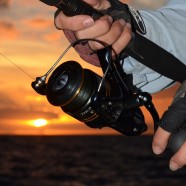Setting The Drag
Most modern fishing reels, regardless of their style or type, are equipped with a drag or “slipping clutch” mechanism of some sort that allows line to be pulled from the reel’s spool under a pre-set tension. On a threadline or spinning reel, drag pressure is usually adjusted via a knob located on the front of the spool or (more rarely) under the rear of the reel’s body. Overheads and baitcasters either have a star wheel under the handle or a lever on the side of the reel for adjusting the drag, while sidecasts and centrepins typically feature a nut or star in the centre of the spool.
This drag is intended to prevent the line from breaking should excessive force be placed upon it. Instead of snapping, line slips from the spool against the pre-set drag tension.

Most threadline or spinning reels have a drag knob on the front of the spool.
When a large or powerful fish is hooked, it usually needs to be “played” using a combination of drag resistance and rod work. The term “playing a fish” means taking your time and bringing the fish in more slowly and smoothly while using the flex of the rod as a shock absorber. If necessary, you will also need to allow the hooked fish to “run”: in other words, to pull line from the spool against the reel’s pre-set drag or slipping clutch. This may happen many times during a fight with a strong adversary, especially on lighter line.
A big, strong fish can easily pull the rod tip down and rip line off the spool against the resistance of the reel’s drag. However, if the drag has been set too tightly, the line can possibly snap, or the hook might bend or straighten and rip out of the fish’s mouth. On the other hand, if the drag is set too loosely, the fish may be impossible to bring in, or it could even strip all the line from your spool!
To stop the fish from taking the upper hand (or fin!), your drag needs to be set firmly enough to tire it out and allow you to ultimately gain control, but not so tightly that the line snaps or the hook pulls.
Playing a fish is basically a form of piscatorial karate, where you use your opponent’s own strength to wear it down. Brute force is rarely the answer, although a “stop ’em or pop ’em” approach may sometimes be necessary on so-called “dirty” fighters such as mangrove jacks, bass, coral trout and the like, especially when they’re hooked close to the cover of snags, rocks or caves.
TO READ THE REST OF THIS BLOG, GO TO “STARLO’S INNER CIRCLE”.



Hey Starlo, would you care to comment how different lines affect the drag settings I should use? I tend to use slightly more drag when I’m fishing mono because it has that shock absorbing quality. For braid I tend to ease back the drag setting slightly to reduce the chance of a pulled hook. Any thoughts on this?
Greg – Yep, I agree. The stretch of mono (nylon or FC) allows a certain “margin for error” that’s not available with GSPs such as braid. On the flip side, however, most braids test WAY over their rated breaking strains (even more so than monos). But you’re right about the likelihood of more pulled (or straightened) hooks with excessive drag on braid. In the end, it comes down to assessing the scenario you’re fishing… sometimes it’s a case of “stop ’em or pop ’em”! Where this ISN’T the case, it’s usually better to err on the lighter side when setting drags, with either line style.
Cheers & Tight Lines,
Starlo